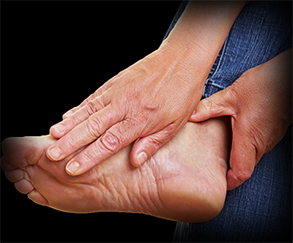
5 timeless habits for better health

What are the symptoms of prostate cancer?

Is your breakfast cereal healthy?

When pain signals an emergency: Symptoms you should never ignore

Does exercise give you energy?

Acupuncture for pain relief: How it works and what to expect

How to avoid jet lag: Tips for staying alert when you travel

Biofeedback therapy: How it works and how it can help relieve pain

Best vitamins and minerals for energy

Should you take probiotics with antibiotics?


Healthy Feet: Preventing and treating common foot problems
Do your arches ache or your heels hurt? Got gout or battling bursitis? If so, you are among the three out of four Americans who will suffer some kind of foot ailment in their lifetime. This Special Health Report, Healthy Feet: Preventing and treating common foot problems, covers the most common foot problems and helps you prevent and treat them.
Other Product Information
Give your feet the care they need. Healthy Feet, from Harvard Medical School, will help you keep your feet looking younger, feeling stronger, and pain-free.
This report will answer questions from how to treat a bunion to how to recognize a stress fracture. Are warts contagious? What causes heel pain? Is there a cure for flat feet? What’s the difference between a corn and callus? Do arches really “fall?”
You’ll learn how to address plantar fasciitis, the leading cause of heal pain, without surgery. You'll gain the know-how to properly treat a sprain, to determine if you've broken a bone, to halt toenail fungus, and to effectively soothe pain of osteoarthritis in the feet.
The report is also packed with practical steps to keep your feet strong, supple, and problem-free. You’ll be alerted to the mistakes people often make when buying shoes, walking, or even clipping nails. Plus, you’ll be briefed on the latest advances in minimally invasive surgery, pain relieving medications, and more.
Discover how you can prevent and treat those conditions that can make walking painful, and how you can achieve and maintain the “foot fitness” that will help you stay mobile, active, and engaged.
Take a step in the right direction and order your copy of Healthy Feet today!
Prepared by the editors of Harvard Health Publishing in consultation with Christopher P. Chiodo, MD Assistant Professor in Orthopedic Surgery, Harvard Medical School; Foot and Ankle Division Chief, Brigham and Women’s Hospital and Joseph A. Hartigan, DPM Instructor in Orthopedic Surgery, Harvard Medical School; Chief of Podiatry, Brigham and Women’s Hospital. 48 pages. (2025)
If you’ve got gout, you feel it. Gout is a painful inflammation of the joints that is becoming more common. Gout causes arthritic symptoms when uric acid, a normal byproduct of digestion, accumulates in the joints. A person with gout either makes too much uric acid or cannot excrete it properly. As a result, the uric acid forms crystals that settle in the joints and cause inflammation, sudden jabs of pain, soreness, redness, and swelling. In the foot, gout most often affects the joint at the base of the big toe.
Although everyone makes uric acid naturally, levels of this compound can increase when you eat certain foods that contain substances known as purines, such as organ meats, sardines, and some shellfish. Purines increase production of lactate, which competes with uric acid for excretion. Gout affects men more frequently than women, probably because men have higher uric acid levels than women. That changes at menopause, however, which explains why men tend to develop gout between ages 30 and 50, while women are more likely to develop it after age 50.
Symptoms of gout
- Jolts of pain in the affected joint
- Possible inflammation in the joint
- Increase in symptoms after eating some foods
Treating gout
To treat an attack of gout, your doctor will usually begin by prescribing an NSAID. Avoid aspirin, as it may raise uric acid levels. If you cannot tolerate NSAIDs or if they do not help, your doctor may suggest a corticosteroid, such as prednisone, to reduce inflammation. Corticosteroids may be taken orally; less frequently, they are injected directly into the affected joint (usually numbed ahead of time with a nerve block). Another option is an injection of adrenocorticotrophic hormone, a compound that directs your adrenal gland to make more cortisone. Although the medication colchicine may be given in pill form, it tends to cause unpleasant side effects (nausea, vomiting, cramps, and diarrhea). To reduce uric acid levels over the long term, some physicians prescribe allopurinol (Zyloprim). More recently, the FDA approved febuxostat (Uloric). The most common side effects of these medications is rash. If a rash appears, discontinue the medication and talk with your doctor. Other side effects include nausea, joint pain and liver function abnormalities.
Your doctor is also likely to recommend making dietary changes, such as drinking more water and eating fewer foods that contain high amounts of purines, such as beef, goose, liver, sweetbreads, mussels, anchovies, and herring. Even poultry, seafood, and some vegetables—including spinach, asparagus, beans, lentils, mushrooms, and dried peas—contain purines. Lowering your alcohol consumption should also help reduce uric acid levels and relieve your symptoms.
- The fantastic foot
- Foot structure
- SPECIAL SECTION: Keeping your feet healthy
- Heels that hurt
- Plantar fasciitis and fasciosis
- Achilles tendinitis and tendinosis
- Posterior heel bursitis
- Aching arches and flat feet
- Flexible flat feet
- Rigid flat feet
- Posterior tibial tendon dysfunction
- Tormented toes
- Bunions and bunionettes
- Hammertoe, mallet toe, and claw toe
- Morton’s neuroma
- Osteoarthritis
- Gout
- Sesamoid pain
- Missteps and mishaps: Foot injuries
- Fractures
- Stress fractures
- Sprains
- Skin and toenail problems
- Ingrown toenails
- Blisters
- Calluses and corns
- Toenail fungus
- Athlete’s foot
- Warts
- Health conditions that affect your feet
- Diabetes
- Peripheral neuropathy
- Skin cancer
- Vascular problems and cold feet
- Foot and ankle surgery
- Types of surgical procedures
- Cosmetic foot surgery
- Treating foot pain
- Shoes for healthy feet
- What to look for in a shoe
- Resources
- Glossary
You might also be interested in…

Living Well with Diabetes
Living Well with Diabetes helps you better understand and manage your diabetes. It includes detailed, updated information about medications and alternative treatments for diabetes, and a special section on weight-loss strategies. You’ll also learn the basics of how your body metabolizes sugar, how and when to monitor your blood sugar, and how to cope with both short- and long-term complications of the disease. Most importantly, you’ll see that it’s not just possible to live with diabetes — it’s possible to live well.
Featured Content
- Recognizing the symptoms
- Monitoring blood sugar
- Weight-loss strategies for diabetes
- Alternative treatments for diabetes

5 timeless habits for better health

What are the symptoms of prostate cancer?

Is your breakfast cereal healthy?

When pain signals an emergency: Symptoms you should never ignore

Does exercise give you energy?

Acupuncture for pain relief: How it works and what to expect

How to avoid jet lag: Tips for staying alert when you travel

Biofeedback therapy: How it works and how it can help relieve pain

Best vitamins and minerals for energy

Should you take probiotics with antibiotics?
Free Healthbeat Signup
Get the latest in health news delivered to your inbox!
Sign Up